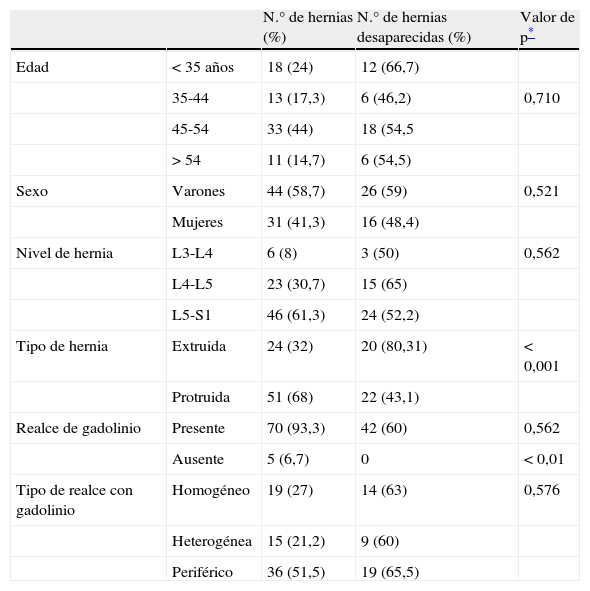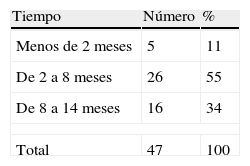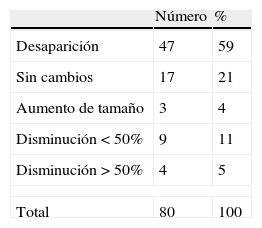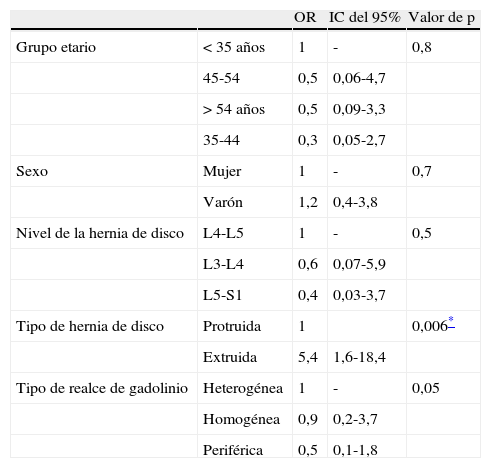Evaluar qué porcentaje de hernias de disco desaparece tras un año de seguimiento y a qué ritmo; valorar si el uso del realce con gadolinio en RM tiene valor predictivo de la desaparición de la hernia; y estudiar si el patrón del realce ayuda a predecir la desaparición del fragmento.
Material y métodosSe incluyeron en este estudio prospectivo 118 pacientes con clínica de lumbociática aguda y que presentaban una hernia de disco diagnosticada mediante TC. A 72 pacientes se les realizó una RM con gadolinio cada 6 meses hasta el año o hasta que la hernia de disco desaparecía, y se relacionó la presencia de protrusión, extrusión y el patrón de realce con la desaparición o persistencia del material discal. Se realizó un estudio estadístico univariable y multivariable.
ResultadosUn 59% de las hernias de disco desaparecieron tras un año de seguimiento, y de ellas el 66% lo hicieron en los primeros 8 meses. Un 83% de las hernias extruidas desaparecieron, y este dato tiene significación estadística en el análisis multivariable (p<0,005). La ausencia de realce tiene asociación con la persistencia de la hernia, con significación estadística en el análisis univariable. El patrón de realce no ayuda a predecir la desaparición de la hernia. Hubo 5 hernias que desaparecieron muy pronto, dentro de los primeros 2 meses.
ConclusionesUn alto porcentaje de hernias de disco desaparecen, se ha encontrado la asociación estadísticamente significativa entre extrusión y desaparición, y falta de correlación entre el patrón de captación de gadolinio y la desaparición de la hernia.
To evaluate the percentage of disc hernias that have disappeared after one year of follow-up and the time to disappearance. To determine whether gadolinium enhancement is useful for predicting whether the hernia will disappear. To analyze whether the pattern of enhancement can help predict whether the fragment will disappear.
Material and methodsThis prospective study included 118 patients with acute symptoms of lumbosciatica and a herniated disc diagnosed by CT. In 72 patients, we performed gadolinium-enhanced MRI every 6 months for one year or until the herniation disappeared; we related the findings of protrusion, extrusion, and the enhancement pattern with the disappearance or persistence of herniated disc material. We analyzed the results with univariate and multivariate statistics.
ResultsThe 59% of the hernias disappeared within 1 year of follow-up and 66% disappeared within the first 8 months of follow-up. The 83% of the extruded hernias disappeared, and this was significant in the multivariate analysis (P<.005). The absence of enhancement was significantly associated with the persistence of the hernia in the univariate analysis. The enhancement pattern was not useful for predicting whether the hernia would disappear. Five hernias disappeared within the first two months.
ConclusionsA high percentage of disc hernias disappear. We found a significant association between extrusion and disappearance but no correlation between the pattern of gadolinium uptake and the disappearance of the hernia.
Artículo
Comprando el artículo el PDF del mismo podrá ser descargado
Precio 19,34 €
Comprar ahora


















